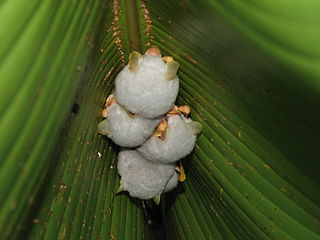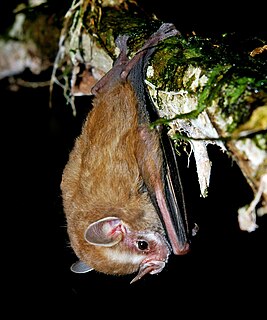
The New World leaf-nosed bats (Phyllostomidae) are found from southern North America to South America, specifically from the Southwest United States to northern Argentina. They are ecologically the most varied and diverse family within the order Chiroptera. Most species are insectivorous, but the phyllostomid bats include within their number true predatory species and frugivores. For example, the spectral bat, the largest bat in the Americas, eats vertebrate prey, including small, dove-sized birds. Members of this family have evolved to use food groups such as fruit, nectar, pollen, insects, frogs, other bats, and small vertebrates, and in the case of the vampire bats, even blood.

The Honduran white bat, also called the Caribbean white tent-making bat, is a species of bat in the family Phyllostomatidae. It is the only member of the genus Ectophylla. The genus and the species were both scientifically described for the first time in 1892. It has distinctive, entirely white fur, which is only found in six of the roughly 1,300 known species of bat. It constructs "tents" out of understory plant leaves by strategically cutting the leaf ribs with its teeth; it roosts in these tents during the day. It is a specialist frugivore, consuming almost exclusively the fruits of one species of fig. Females can likely become pregnant twice per year, giving birth to one offspring at a time.

The short-headed broad-nosed bat is a bat species found in Bolivia, northwestern Brazil, Colombia, Ecuador, French Guiana, Guyana, Peru, Suriname and Venezuela.

The buffy broad-nosed bat is a bat species found in Bolivia, western Brazil, Colombia, Ecuador, and Peru.

The southern little yellow-eared bat is a frugivorous bat species found in Brazil, Argentina and Paraguay.

The bidentate yellow-eared bat is a species of bat in the family Phyllostomidae, native to South America. Formerly classified in the Vampyressa genus, phylogenetic analyses support its inclusion in Vampyriscus.

Vampyressa is a genus of bats in the family Phyllostomidae, the leaf-nosed bats. They are known commonly as the yellow-eared bats or yellow-eared vampire bats.

Melissa's yellow-eared bat is a species of bat in the family Phyllostomidae. It is found in southern Colombia, Ecuador and Peru.

Stenodermatinae is a large subfamily of bats in the family Phyllostomidae.

Vampyriscus is a genus of bats in the family Phyllostomidae, the leaf-nosed bats.









